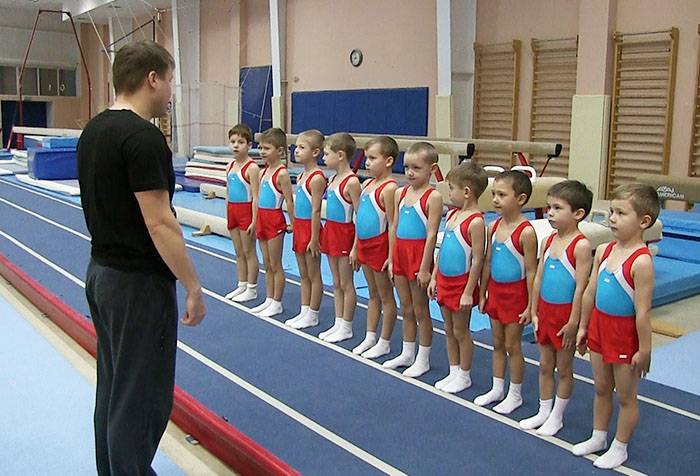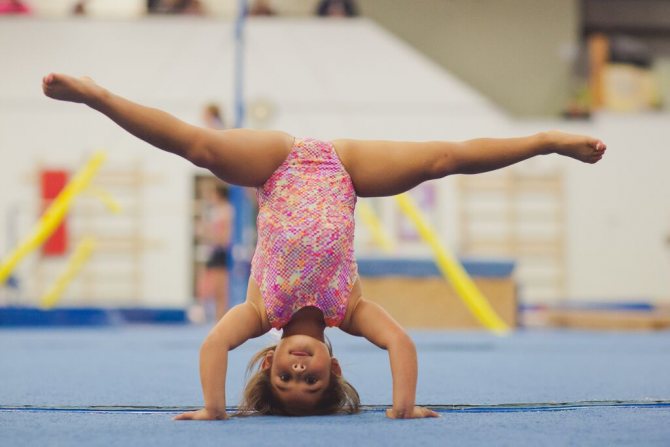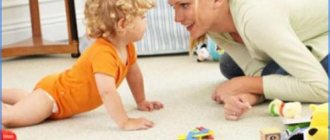Girls and boys
While rhythmic gymnastics is only open to girls, sports gymnastics is open to boys as well. Developed muscles, a strong physique, the habit of constant exertion and the development of discipline go along with gymnastics training. For boys, this is a huge plus, both for general physical health and for strengthening character and the ability to cope with difficulties. However, gymnastics is not included in the top 10 popular sports among boys due to concerns about possible fractures and stunted growth in adolescence.
Artistic gymnastics combines strength and beauty. The gymnastics girl’s body is perfectly built, perfectly stretched and toned. Usually, when selecting girls for professional sports, coaches focus on short stature, narrow pelvis and lightness. It is easier for girls with this body type to perform acrobatic elements, jumps and achieve high results in sports. For example, Olympic champion Svetlana Khorkina is only 165 cm tall.
How to choose a gymnastics section for children
Choosing a gymnastics section for a child is a responsible matter. If you send your baby to sports for general physical development, you can choose the section that is located near your home or school.
If you see your child in professional sports, pay attention to Olympic reserve schools. Our catalog of sports sections will help you choose the appropriate section.
Gymnastics as an Olympic sport is not suitable for all children, but other types of activities are an excellent way to strengthen the immune system and guarantee the child correct posture, a slim figure and endurance. Remember that any sport in childhood is the key to health in adulthood.
From what age
The most optimal age to start classes is 5 years. But sometimes artistic gymnastics sections accept children at both 3 and 4 years old. The key role here is played by the coach’s opinion on what age to start training. Maximum age is 8 years. After that, it’s too late to come to big sports, since you won’t be able to achieve outstanding results.
At first, the child performs exercises for general physical development, being in the preparatory stage for more special and difficult elements for artistic gymnastics. After general training, you can go into any other sport, so gymnastics is a great place to start.
At what age should I start?
When deciding to send a child to a sports group at the age of one and a half to three years, parents need to remember that in this way they provide him with the opportunity to vent his energy, and performing various movements not only strengthens the body and helps to form correct posture, but also promotes mental development.
Exercising with children has a beneficial effect on various internal organs, the heart and blood vessels, and the nervous system.
Pediatricians advise paying due attention to the following exercises:
- exercise at least 10-15 minutes a day;
- Perform each exercise 5-8 times;
- include age-appropriate tasks in the complex.
Such gymnastics is indicated for children 1-2 years old, but to perform it there is no need to visit any specialized institutions or tire the child on a long journey. It is quite enough to study at home with your mother to your favorite music, alternating between exercise and relaxation.
From the age of 3, you can teach your child to skate; this type of training will develop dexterity, help the child acquire and maintain beautiful posture, and improve coordination of movements. Swimming lessons are acceptable from this age. However, it is important to remember that, despite their energy, children 2-3 years old get tired quite quickly, so it is necessary for them to alternate between workload and rest, each lesson should be carried out at an accessible rhythm, without causing the child to become overtired.
Children from 3 years old can start training in rhythmic gymnastics, synchronized swimming, and figure skating. For these coordination sports, age matters: the earlier you start training, the greater the chance of success.
By the age of 4-5, children develop their physique and character, so most pediatricians believe that this age is optimal for starting to attend sports clubs in gymnastics, wrestling or another sport.
Finally, at 6 years old, a child can attend numerous sections in figure skating, dancing and gymnastics, tennis and acrobatics, and football.
However, it is impossible to give an unambiguous answer to the question at what age to send a child to a section. It all depends on the individual characteristics of the baby and his desires.
Minuses
- Constant training, an increase in muscle mass, and increased stress on the child’s spine affect the development of growth. Most parents note that the child grows poorly when other children noticeably stretch out during adolescence. Coaches explain this by the characteristics of genetics and the fact that children with short stature are selected for professional sports, which will allow them to achieve success in international competitions in the future.
- Girls, due to the high load on the body, experience late puberty and problems with the menstrual cycle, which, in principle, can happen in any sport.
- Injury hazard. Jumping, exercises on the pommel horse and uneven bars seem dangerous to an unprepared person and threaten the health of the future champion. In fact, until the age of 7, a child is engaged in general physical training; only after 2-3 years of training does he move on to special elements. Each element is worked out in detail and gradually, but, unfortunately, does not reduce the percentage of injury to zero.
How much do classes cost?
Children's and youth schools recruit young athletes for free. Among trainers, it is common practice to make regular contributions for new equipment and powder for performing exercises on uneven bars, which amounts to at least 500 rubles. per month. If we talk about private sports centers, then 8 gymnastics classes in Moscow will cost from 5 to 8 thousand rubles. Plus, in both cases, parents buy sportswear for training and bear the costs of sports competitions, which can reach 25 thousand rubles. per month.
Activities for the little ones
Modern sports institutions offer various complexes for children from one year old; training is carried out with the obligatory presence of a parent who helps the child complete tasks. Such programs include the following:
- performing exercises on an obstacle course aimed at developing coordination and strength;
- educational games with objects (cubes, balls, hoops, tactile circles);
- tasks to develop walking and climbing skills;
- fitball exercises;
- trampolining.
Such training has many advantages:
- classes will help to form the most important skills for full development in a safe environment for the baby - under the supervision of an experienced teacher;
- training will give a lot of pleasant moments to the child and the parent, will help strengthen the baby’s immunity, and will contribute to his harmonious development;
- will allow you to create a muscle corset.
Often, training is structured in such a way as to give the child an initial understanding of counting, shape, and color of an object. They are aimed at strengthening discipline, making it possible to form correct posture, improve flexibility and endurance. Regular sports activities will help your child gain self-confidence and become purposeful.
For children over 2 years old, special sets of exercises have been developed on uneven bars, horizontal bars, and rings. There are soft mats on the floor in the hall, so the fall will be almost painless for the baby.

How to choose a section
You can practice gymnastics in both private and public sections. In private schools, in addition to group training, it is possible to take individual lessons.
First, the child undergoes general physical training, so for the first 2 years, parents can save money and send the child to a regular youth sports school. Afterwards, focus on the coach and decide whether it makes sense to stay with your mentor at the Youth Sports School or send the young athlete to a registered vocational school. For example, in Moscow, world and European champion Alexei Dudchenko has his own gymnastics school.
What is artistic gymnastics?
Many children, and even parents, are excited about the idea of taking up this sport, but not everyone understands what data they need to have for this, and what problems may arise during the training process. To begin with, it is important to understand what artistic gymnastics is, since people often confuse this sport with acrobatics, where completely different athlete skills are put in the foreground.
So, artistic gymnastics is a discipline in which competitions are held in vaults, on gymnastic apparatus and in floor exercises. There are different programs for girls and boys.
If your child is already in his third year, you can interest him in gymnastic exercises. To do this, it is important to find a coach who will do his job with dedication and pay due attention to the child.
In the Yourways network of sports schools in Moscow, anyone can learn the basics of artistic gymnastics, regardless of age and skills. We also educate young athletes aged 3 years and older. You can only become a master of sports in the field of artistic gymnastics at a young age, so you need to start training for flexibility, strength and endurance from an early age. This gives you an advantage over other athletes.
Yourways school will delight you with a high level of training of trainers (candidates for master of sports and master of sports), a wide range of classes for adults and children, huge halls with new equipment, the opportunity to study with a 10% discount on the first subscription, attend the first training session for free to draw conclusions about whether this sport is suitable for you or your child.
Today we are members of the Trampoline Federation and in the near future we will become members of the Artistic Gymnastics Federation, which opens up opportunities for us to train masters of sports.
Psychological portrait of an athlete
The main traits of a gymnast: endurance, patience, perseverance and tenacity of character. The child must be purposeful and ready to perform the same elements to standard performance. Lack of fear and self-confidence play a significant role, because you will have to jump, climb high on the horizontal bar and perform exercises on a horse. The child’s psychological attitude will be reflected in the future and on his results, so the sooner you teach him to focus and overcome failures, the better.
“I trained until one or another difficult element began to work out. I forced myself to go to the gym even on Sundays. It was this self-discipline that helped me a lot in the future. I believe that sport in general has changed my life a lot - it has helped me strengthen my character and become more reasonable,” says Alexey Nemov, who expresses his gratitude to sport.
Additional Information
- We bring to your attention information about the Apgar score, which will be of interest to all expectant mothers, because it is the one used to determine the condition of the newborn baby.
- Many parents are also interested in such a term as children's health groups, so you have a great opportunity to familiarize yourself with this information.
- Well, if your child is at an active age and he constantly wants to learn something, we advise you to familiarize yourself with the daily routine for a child aged 1-3 years, which will help mothers properly organize their baby’s time.
Has morning exercise become a good habit for your child? At what age did you start doing morning physical education, and what methods did you use? We will be glad if you share your stories and tips in the comments. And also don’t forget to leave your reviews.
We recommend reading:
- Educational finger games for children 1-3 years old The best educational games for children from 1 year old When a child begins to sit independently When a child begins to roll over: timing, tips for parents
What difficulties might you encounter?
Injury hazard
In any gymnastics, the athlete is pulled and has to overcome pain. Torn ligaments are the norm in this sport. In addition, during training, athletes break joints, twist their arms and legs, and when landing on foam rubber, they knock off their knees and break their backs. By doing gymnastics, a child learns to be more relaxed about any type of injury and to be prepared for something like this. He cannot calculate a successful landing, and if the arm is in an awkward position, it is easy to dislocate it.
A lack of money
You can only receive winnings from international competitions. Neither the Cup nor the Russian Championship will bring anything other than a certificate and words of gratitude. It is possible to make a career and start making money in sports only after a good performance at the Olympic Games. The athlete’s salary also depends on the city’s sports committee; in some places they provide benefits, but in others there is no interest in artistic gymnastics, as well as financial support.
Artistic gymnastics: what is it and who can do it, difference from rhythmic gymnastics
The main “working” equipment of rhythmic gymnasts are small clubs, gymnastic sticks with ribbons, balls and hoops. During the performance, the girls not only perform various exercises to demonstrate their stretching and physical strength, but also show how deftly and artistically they can manipulate the props while simultaneously coordinating their many movements.
Gymnastics for children is exercises on trampolines, parallel bars, horizontal bars, mats, and goats. This sport is not suitable for young children - it is too dangerous. One wrong move and the baby can suffer serious injury, ranging from broken arms and legs to spinal damage and concussions. Gymnastics training should be conducted by an experienced trainer, and the equipment of the gym should be modern and new - this partly guarantees the child’s safety during classes.

Let's sum it up
Artistic gymnastics is a sport that requires tremendous endurance, patience and endurance. A sport that strengthens your child for the rest of his life. The child learns to overcome difficulties and fear, endure defeat and rely only on himself. All elements are performed alone, and the final result depends only on him. The gymnast understands how to take responsibility and that a sprained palm is not the end of a sports career. Having survived gymnastics school, the child knows how to set goals and achieve the impossible on his own.
Professional training
- It actually gives a ready-made profession as a coach; a child can become a coach after the first adult level.
- Opportunity to earn prize money in competitions.
- Gymnasts know how to set a goal and achieve it.
- In some countries, such as the United States, athletes are highly valued and may be offered free training.
- A famous champion in medium-sized cities in Russia can even get an apartment, if only he could speak on behalf of the city or work as a coach at a sports school. This is a matter of prestige and great experience that an athlete can convey, having trained with the best coaches and social connections in sports circles.
- The desire to buy a new tights or gymnastics accessory can, with the proper approach, develop the ability to accumulate money and treat it with care.
- An accomplished gymnast can take up another sport, as well as master a profession that is based on gymnastics - acrobatic dancing, circus sports, etc. For example, circus performers among former gymnasts are highly valued abroad with a minimum salary of about 3,000 US dollars per month.
- Male gymnasts look like real athletes, and this helps to find better jobs even in a non-sports field, and the pay may be higher than that of an insecure applicant.
- Gymnastics experience allows you to pass it on not only to your children, but also to engage in teaching activities in sports clubs of various types - from fitness to bodybuilding; retraining, if necessary, occurs very quickly.
- Due to their specific nature, gymnasts receive a certain level of medical education and understand situations related to injuries and safety precautions.











